
|
Here
you'll see some pics of my equipment and other stuff.
The newest pics are at the bottom.
Note that
none of this is for sale, not for ANY reason.
Click the thumbnails to see larger pics....
|

Some adapters to read surface mount ROMs. These suckers are
*hell* expensive! These total around 2k!
Here is a listing of standard
devices with which some of these adapters are used.
Also shown are a few custom made adapters that are used with
normal type MASKROMs. These basically just swap some pins
around to get proper reads on some weird MASKROMs. |

My crappy old 20MHz CRO. Picked it up for 150 bucks!

My EPROM UV eraser. Was around $120 I think. |
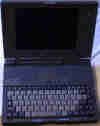
My crappy 486 laptop used for "On-Site" dumping. Cost me
about 2k when it was new, now I couldn't give it away! I
actually use this now exclusively with the Data I/O Unisite
shown below. |

My EPROM reader. cost was around 2.5k.
Why so expensive, you ask? Well, the reason my reader is so expensive is because it supports over 8000 different devices (and new devices are being added daily).
It is very unique in that the pins on the reader can be configured to any combination with the software. So just one adapter can be used to read all devices with
the same physical shape, even though the actual device has a different pinout and function.
The software is able to put power, gnd, address and data lines where-ever the device needs it, thus resulting in a more economical piece of equipment.
Using a general-purpose EPROM reader (*much* cheaper and looking almost identical), you would need to buy 50 (or more) adapters to handle all devices, instead of just
a few like me :-) |

My test unit that I use for repairing PCBs. Note two 14"
screens, can be switched to view any game horizontally or
vertically. Has adjustments for voltage, volume, and screen
flipping Horiz. & Vert.. plus an ammeter (VERY handy for
showing PCB shorts!), credit, test and
service switches. I made a custom control panel using standard
arcade parts that is connected to it (you can just see the
wires on the bottom left side of the pic). All this I built myself from parts obtained from
Filtek Australia.
|

My surface mount equipment. Called a PDR Solderlight. Uses
infra-red technology. Cost around 4k You can read more about
it here. Check the
other pics below for a closer look. |

WOW. This is the tidiest I've seen my desk in years! Net PC
to the right, is a P2-266, main PC under the desk is a P4-2GHz
with 512M RAM and 64M Geforce 4. Screen is ADI M900 (19"). Both
are networked together. I use an electronic 4 port KVM
switchbox made by Avocent called a SwitchView which allows me
to swap between both machines with just the touch of a button,
using only one monitor, one keyboard and one mouse. It's
heaven, believe me ;-) |
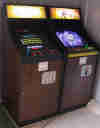
My two arcade cabs. They're simple, small upright cabs with
20" screens. I repaired them myself and repainted and fixed
them up to be like new. One on the left has Galaga in it ATM,
the right one has Ultimate MK3 in it. |
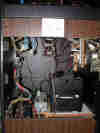
The guts of one of my cabs looking through the front
door
|

This is my baby. 20" cocktail, repainted and
detailed to be like new. Replaced top glass and repainted the
design underneath. Chassis and tube are by Nanao.

Inside view of my cocktail. |

Another cocktail view with top up. |

Another view of the guts of my cocktail machine.
|

My car (from 1996-2008).
It went from A to B
FAAAAAAST!
|

My Nikon Coolpix 995 digital camera. Pic taken from the
Nikon website. Pretty hard to take a pic of a digital camera with
the same digital camera. I could use a mirror, but well.... |

My Sony mini disc player/recorder. Model MZ-R700 which I
use for sampling sounds from arcade machines. |

My heat gun. Very useful for
removing stubborn IC's from junk PCBs. |

My Colecovision, in the original (if slightly weathered) box.
It still works too!

The Colecovision exposed. Still looks brand new. |

The Colecovision wheel. Yeah I got one of those too, with
bonus Turbo cart! Still got the box and original packaging
too! |

An old C-64 that I bought for parts to fix my SX-64.
This one needs repairing, it's got one bad RAM chip. Update:
Finally got around to looking at this repair job, fixed it in
5 minutes. The sound is missing though, since I stole that
chip to repair my SX-64!
I have fixed this a total of 5 times now. 3 times were bad RAM, replaced the bad power pack and the last repair was a bad transistor causing the floppy drive to not work correctly. |

My sound system. Sony surround sound amp model STR-D790, Sony 10
stacker CD player model DP-C910 and Sony Hi-Fi stereo VCR
model SLV-EZ7. (PSX on top of
that; it's an SCPH-7002). This is all hooked up to my PC and sounds great with
MAME and other emulators :-) |

My Commodore SX-64 and Commodore 128D. I never bought an
SX-64 when they were released (too expensive!) but I did buy a
C128D, though I swapped it for a C128 and separate floppy
drive after about 1 year, which I eventually traded on an
Amiga 1000 (which I no longer have). Funnily enough, a friend gave me
the C128D and SX-64 for
free just a few years ago. |

My Amiga 2000.
Sadly I haven't powered it up in years. Update! Powered it up in 2010 and use it fairly often now. See 'The Amiga Desk' below.... |

Overall view of my smt equipment laid out on a desk
where I'm about to use it. |

This is the control power box used for setting temperatures
on the backheater and hand IR unit. |

The backheater in use, gently warming a PCB from the
back. This is the 'key' to surface-mounted work. Without the
back-heater, it's almost impossible to remove components
without moving or damaging surrounding components. Well, you
can do without it if you don't care and do as Randy Fromm
suggests..... heat it up with a blow torch and belt it across
a wooden table. That will get ALL your components off at once!
LOL!! |

A close up of the hand IR unit sitting in it's stand. It's operated by a foot pedal, which you can see in the overall view pic (3 to the left) |

The hand held IR unit in action. The red light is pure
infra-red heat, which is focused precisely on the component
being worked on. Since the back-heater has already warmed the
PCB, it only takes a few seconds extra to heat the component
slightly more before it can be removed easily. |
|

This is my sexy new laptop. Well it was new in about 2001 anyway.
Toshiba Satellite 2430. Specs are.... Intel P4-2.4GHz, 256M
PC2100 DDR SDRAM, 30GB HD, 15" TFT, 24x/10x/8x
CD-RW/DVD,NVIDIA GeForce4 GO420 w/32MB DDR, Integrated 56k Modem
and 10/100 Ethernet, TV Out, 3x USB 2.0 ports, Integrated IEEE
1394 Firewire, and lots more :-) |

Frequency counter for
measuring.........
frequencies ;-)
This particular model can handle up to 1300MHz and has 7
digits of precision on the right side of the decimal point.
This is used to check the clock frequencies of some chips on
PCB's so the emulation is more accurate. |

No this isn't a 1960's typewriter
(though it is as heavy as one). It's a Data I/O Unisite EPROM
programmer. With it is the SETSITE 8-Gang Module, the SITE48
DIP adapter, and the PINSITE Module with the PLCC module and 6
PLCC adapters (to suit 20, 28, 32, 52, 68 and 84 pin devices).
This baby can handle just about any device on the market. It's
very nice and was HELL expensive. Believe it or
not, to buy this unit with the options you see here costs
US$35000 as quoted from Data I/O. Though it actually only cost
around 2% of that, thanks to Gyrovision and some sneaky eBay
sniping ;-))
UPDATE: Unfortunately this isn't as useful as first thought.
This unit has only enough 'pin-drivers' to support up to 44
pin chips. So it's basically useless except for reading what
we bought it for (68705 microcontrollers) since the extra pin
driver boards cost $600 each and to utilise the PLCC84 module
(and read up to 84 pin ROMs) would require 6 extra pin driver
boards, coming to a total of $3600. That's more than the total
cost of the newest BP Micro programmer I bought! |

My Sega Saturn. Very nice little
gizmo, there were some great games on it. I got this as a
reward for repairing a fairly rare Japanese white Saturn that
had a busted cart slot (I exchanged the slot from a dead
Saturn PCB). It was a nightmare job though, so don't even
think about asking me to repair another one! Well, not unless you are going to give me something similar as a reward :-D |

This is my Nintendo 64 bundle.
With the help of EFX, I picked up the N64 with 1 controller
(basically what you would normally get in the regular retail
box) from Ebay for AU$37! I
never thought I'd buy one of these! This one is real nice,
even got the box and it's in pretty good condition too. Believe it or not, this is
a dumping tool. In the pic you can see the N64 console,
controller and a few carts (Pokemon Snap, Lylat Wars, Star
Wars Pod Racer, WCW Vs nWo World Tour, F1 World Grand Prix,
007 Golden Eye and Super Mario 64. Plus a N64 rumble pack. I
got the rumble pack and the carts for AU$24 total from a second-hand
shop just down the road from me! On
the right is the gizmo used to dump N64 carts, called a 'Dr
V64 Jr.' which can handle up to 256M carts. That Pokemon Snap
cart looks very innocent doesn't it? Actually, no, it's
extremely sinister --------> |

This is no ordinary Pokemon Snap
cart. It's a multi-purpose dumping cart. The custom
serial MASKROM and CIC (aka protection) chip have been socketed by
me so it's possible to swap any game chips into this cart and
dump them easily. Well, for dumping N64 carts, chip swapping
isn't required. But there are some arcade games based on N64
hardware that use the very same chips. It was really nice of
Nintendo to provide the dumping tools, wasn't it ;-) |

My Sega Dreamcast bundle. Again,
this is a dumping tool which is being used to dump the NAOMI
GDROMs using a Broadband Adapter and 'DreamRip'. Of course, I have 'tested' a few games
too... the DC has some
really great arcade games for it, especially Daytona 2001 :-) |

This is a HP10529A Logic
Comparitor. It allows me to check TTL logic chips in-circuit
when repairing arcade PCBs. There is a small ZIF socket for a
logic chip which is used to compare it to the one on the PCB.
The test clip fits over the chip on the PCB and then it's
powered up and the LEDs on the unit show any difference
between inputs and outputs of the two chips. It's a very handy
device for PCB repairing. Of course, with TTL logic no single
method is 100% effective, it has it's caveats, but it's better
than nothing, and much faster than regular methods of testing
digital circuits. |

More Dreamcast stuff! Well, I
did want some original Sega controllers and there were many
games for sale at the same pawn shop, so I grabbed some of
those too! You can see the two controllers (one even has an
original box! woohoo!), and five games; Soul Calibur, House of
the Dead 2, Sega Rally 2, Crazy Taxi and Dynamite Cop. Picked
all this up for a measly AU$80 total. I'm not sure why though,
maybe I'm hooked! |

Yep, it's an electric guitar.
Not exactly a dumping tool.... well you could say it is a
dumping tool, it stops me from getting bored while I wait for
certain dumping-related things to happen ;-) |

Oh! More Dreamcast stuff from
pawn shops! Picked these up for AU$5 each and the Sega
lightgun for AU$25. Yep, looks like I'm hooked! |

This is a magnifying lamp for
use when re-mounting surface mounted ROMs, especially those
tiny TSOP48 & TSOP56 ones. Aarrgghh! Unfortunately the ones
that use _real_ glass lenses are not cheap, this one was
around $400. But it is very nice quality, using a 'cool white'
fluorescent tube (very very clear and bright) and is
definitely required for surface mount work. |

Another (very expensive!) EPROM
programmer.... BP Microsystems 1400/84, supports approx. 19000
devices, and 5 modules for use with various package types.
There's another module on the way, which will be added here
later. This is being used to read some of the more 'exotic'
types of devices found on arcade PCBs. Although this unit is
MUCH more powerful than my EETools programmer, I don't have
all the modules required so this is for use only with certain
types of ROMs that are not supported by the EETools
programmer, for which I have those modules. Mostly this will be used for dumping PLCC and QFP
devices. Or attemping to dump them, at least ;-) |

Yep! Another EPROM programmer.
This one is made by Hilo Systems and is model ALL-11P2. This
was the first one I bought at the beginning of the year in
2000. With it comes a standard DIP40 ZIF socket, and it's
serial (ughh!) so I rarely use it nowadays. However, I
recently discovered that this unit (with some
Hilo-manufactured adapters) supports reading some other ROMs
that the other 3 programmers don't support. So this turned out
to be a worthwhile purchase after all :-)
The 3 adapters are (from left to right) ADP-29PL160-TSV2,
ADP-647180-Q (for HD647180) and ADP-TMP9-SD (for TMP91P640N).
The adapters were seriously expensive though, these 3 alone
cost AU$1020 ! |




One of my latest additions....
Japanese Taito Egret II cabinet. Has 29" 15-31KHz monitor
which can rotate in about 30 seconds. Lovely :-)
I use this mostly just for testing PCBs since it can handle
everything known to mankind :-) |




I'm not sure if I'm crazy or
not? After I bought my house, I decided I should get a
driving game. My favourite one was always Sega Rally 2......
I mean Daytona is ok, but the feedback on Rally 2 is really great which makes the game very realistic to play. The hardware is Model 3 from 1998, so it's far superior to
the old Daytona PCBs. This
one is in perfect condition, all plastics have been replaced
with new parts, new sideart stickers, monitor is bright and
everything is just amazing. These pics are from the showroom where I bought it. See below for current pics
If you want to see some other
perfect condition cabs, check out
Arcade Fever.
This guy is even crazier than me ;-)
Current Sega Rally 2 pic as of Nov. 2008....

|


A couple of pics of my storage
room where I've mostly just dumped everything temporarily.

4 of my cabs, again, just
dumped there when I moved house.
|


Just a few guitars, that's all
;-)
2nd pic shows a close-up of my favourite one. It's a Jackson Dinky
custom with Floyd-Rose locking tremelo and Seymore Duncan
pickups.
OH Y-E-A-H |
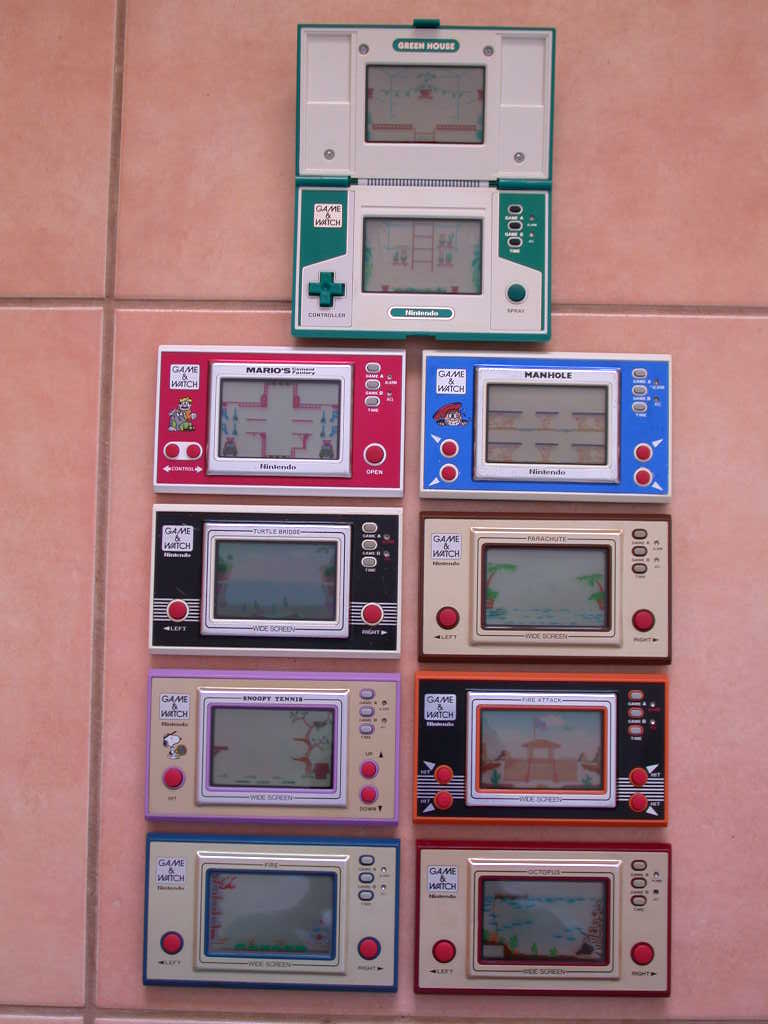
Nintendo Game & Watch collection..... Green House, Mario's Cement Factory, Manhole, Turtle Bridge, Parachute, Snoopy Tennis, Fire Attack, Fire, Octopus
All of these are in really nice condition. I've replaced the LCD filter on Octopus because it was faded. If you didn't know, the LCD has a special polarizing filter in front of it that allows the LCD characters to show as dark grey on the screen. Without the filter there are no characters on the screen. Over time the filter fades and the characters go brown or worse, are not visible at all. You can buy this filter material and make your own replacements. They come in sheets of various sizes. Because of the way the filter works, as the filter is rotated the screen can go from reversed dark background and light characters to normal light background and dark characters. Be sure to cut the filter at a 45 degrees angle on the sheet you buy otherwise you'll get the wrong look on your Game and Watch screen. If you are not sure just put a new uncut filter in front of a Game & Watch screen and rotate it and you'll see how the position affects the view. You can buy the filter from a place called 3D Lens in Taiwan. Buy product P100. Here's a direct link. They sell other types but they are too dark for use as a replacement Game & Watch screen filter. There are larger sheet sizes too but only buy the Polarizing Filters with 43% transmittence, otherwise the screen will be slightly darker than the original.
|


Some bits and pieces I was
playing with in mid October of 2005. The right pic is the
latest piece of equipment I have acquired. It's basically a
hot-air blower for surface-mounted repairs. It also comes in
very handy for removing and replacing surface-mounted
FlashROMs. I'll let you figure out _why_ I would want to do
that ;-)
Special thanks to R.Belmont for helping me to get this from
one side of the planet to the other. |


Here's a few pics of my home
arcade, with lights on and lights off :-)
From left to right..... small 20" cab running Konami 80's
Classics, small 20" cab running Ultimate Mortal Kombat 3,
26" Neo Geo cab running Sega Tetris (System16B), Sega Rally
2 Twin, Taito Egret II cab with 29" WG D9200 monitor running
Atomis Wave Dolphin Blue (atm). A 20" mint condition Hankin cocktail is next to
that (powered off in the pic) |
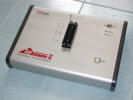

Yeah, that's right, ANOTHER
EPROM programmer! This is the latest gizmo on the market and
supports most of the newest types of surface mounted
FlashROMs. It's also USB2 and
F-A-S-T! The older TopMax is parallel and the software has
some problems when hooked up to a Pentium 4 >2GHz that the
manufacturer won't admit or fix, so I bought the TopMax II
instead! |

This is a BK Precision 1570A Oscilloscope.
It's 80MHz and has quad trace and dual time-base. Probably worth $3000+ here,
but was a gift! Big thanks to Russ from Streetstate Amusements in the good old US of A! |

These are some logic probes and a logic
pulser. These are VERY helpful when trying to repair logic faults on PCBs.
The logic pulser is especially useful for activating logic chips in circuit. If you suspect
a chip may be faulty, pulse the input pin(s) while probing the output pins with
an oscilloscope or logic probe. If the pins respond the chip is probably ok. If there's
no signal coming from the output pin that you're probing you can be fairly certain the
chip is bad. |

This is a HP E2310A Logic Dart. It's sort of a mini 5MHz oscilloscope,
frequency counter (to 20MHz), voltage tester, logic probe and data aquisition gizmo. It cooks dinner too!
No, not really ;-)
|

This is another logic comparitor made by BK Precision, model BK552. It
can test any logic chip up to 20 pins automatically, no need to configure this one. Just clamp onto the
chip on the PCB, put the same type of chip in the ZIF socket, then press the test button. It knows exactly
what chip it is and displays any mis-matched pins on the LED display. It can even handle tri-state chips,
which are a real pain-in-the-ass to check, usually. These things are getting very very difficult to come by
nowadays. I picked this up on eBay for about US$300 I think. |

My newest toy purchased in December 2007 is a Hakko 474 Desoldering Gun. Mucho expensivo at about
AU$850 but highly recommended for quick removal of soldered-in ICs. This can remove any DIP chip or
soldered-through IC even in a 6-layer PCB in just a minute or two. Be careful though, it has tremendous sucking
power, so don't stand too close when using it or it will suck the end right off your co.... err, it's mighty powerful ;-) |

Holy crap! Another EPROM programmer! This is made by Hilo Systems and is model ALL-100 with
high speed USB2 interface. This one replaces the obsolete ALL-11 serial programmer above and cost about $1800.
It comes standard with a ZIF48 module for up to DIP48 chips and I also got the TSOP48 module ($350 extra!). It has some
really nice additions like some ROMs that no other EPROM programmer supports! That will come in _very_ handy for
many of the newer PCBs :-D
|
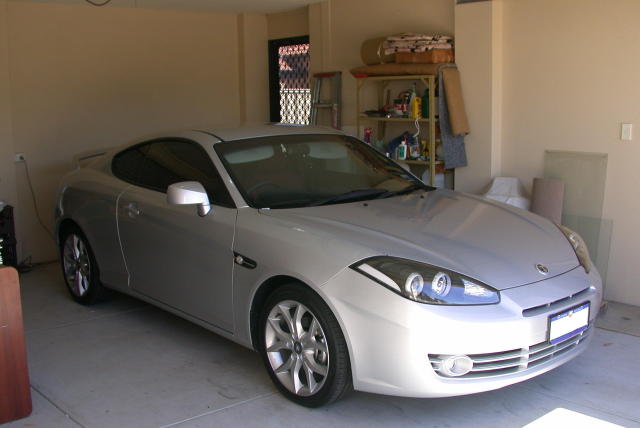
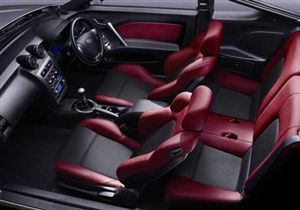


My new car :-D
It's a Hyundai Tiburon. V6 2.7L
Delivered November 3rd, 2008 and on the road at $42k.
Apparently 'Tiburon' means shark in Spanish. It certainly eats the road anyway ;-)
To get this I had to do a special order then wait for 5 months! I guess that's because it's so fast most people can't handle it, so the car
dealers don't keep many in stock. Anyway, I have it now. First pic is the real thing, other pics are stock photos because I'm too lazy busy to take
more pics ;-) |

Here's a couple of Sega Astro City cabs I picked up locally at the right price. Unfortunately these were pretty dirty, stinking of cigarette smoke
and full of dirty black dust inside. But overall they are in really good condition. Just need a bit of a clean and a few touch-ups with some
white paint and they'll look real nice in my arcade :-D |

Apple Imac 'Bondi Blue'
Given to me by a friend. Dunno what I'm going to do with it, but it works anyway. It's running Mac OS 10.4 'Leopard' and has 192M RAM.
I decided to go back to an earlier O/S since I have a MacBook Pro running OSX, so it now runs OS9.2 or something. |



Some more Amigas.
A600, A4000 and A1200.
There's an interesting story to go with the A600.
I bought it as an original A1200 on ebay. The seller sent
it surface mail which took several weeks, but of course as anyone knows you only have 60 days to make a claim with Paypal if it doesnt
arrive. And it didn't arrive within the allowed time so I filed a claim after 58 days stating it didn't arrive. Anyone who has filed a
claim will know that the claimer always wins because of Paypal's stupid automated system. When it finally did arrive several weeks
after that, I opened the package to find a Commodore A600! WTF! Thanks bud, I'll keep it anyway. Thanks also to Paypal for the full refund.
Gee aren't they nice people over there in the US, sending me free Amigas and refunding money. I'm all choked up inside.
Thanks guys! |


Another nice Commodore SX64 and a mint condition Commodore 64 (newer type). Unfortunately the SX64 isn't as nice as it should be.
The keyboard doesn't really work properly because of the poor design in the way they used a black carbon skin to trigger the keys which
tends to break-down over time and not connect properly (my other SX64 is the same!) and custom sound chip is bad, it's only outputting sound on 1 channel and
those chips are impossible to find now :-(
The C64 is the sweetest thing I've seen in years. At least computer-wise anyway. It came out of a juke box machine that was being
used to run a Beta VCR that plays music videos. The computer had a plug in cartridge in the back containing some ROMs and another
board in the user port containing a 6802, a couple of 6821's and some more ROMs. The C64 was locked up under a hidden panel and never
saw daylight for about 20 years so you can imagine how it looked. A little bit of surface rust had formed on the inside on the metal
shield which was easily cleaned up but the PCB inside and all chips are perfectly preserved. It's the newer C64C type released in 1986.
After a bit of a clean up it looks like it just came from the factory :-D
The thing plugged in at the back is a MMC Replay. It's basically a cartridge but the great thing about it is it can run .D64 (etc) images which
are stored on a SD flash card. All you have to do is save a whole pile of images on the card and plug it in. A menu comes up and you can select
any item and run it on a REAL C64 :-)
Here's a closer look at it....

|


A really nice Atari 2600jr that I got for free from my good buddy Rusty (from ex-Filtek)
It was covered in dust, but after a clean-up it looks great and works fine. I had one of the older wood-grain A2600's many years ago
(now gone) but I still have one cart lying around (Asteroids). Plugged it in and it's working fine :-D
|


My really nice Bally Midway Eight Ball Champ pinball machine. It uses the rarer 6803 hardware. I bought this not
working and fixed it in about 6 hours. I took this one because the opportunity was there (good pinballs are hard to find and expensive as hell) but also because the playfield was
in really good condition. Over the next 3 years I spent time working on it detailing every part and bringing it back to
factory specification. Now it looks and plays like it is new. The backglass is not 100% perfect but easily a 9.5
You can see more detailed pics of it here
|
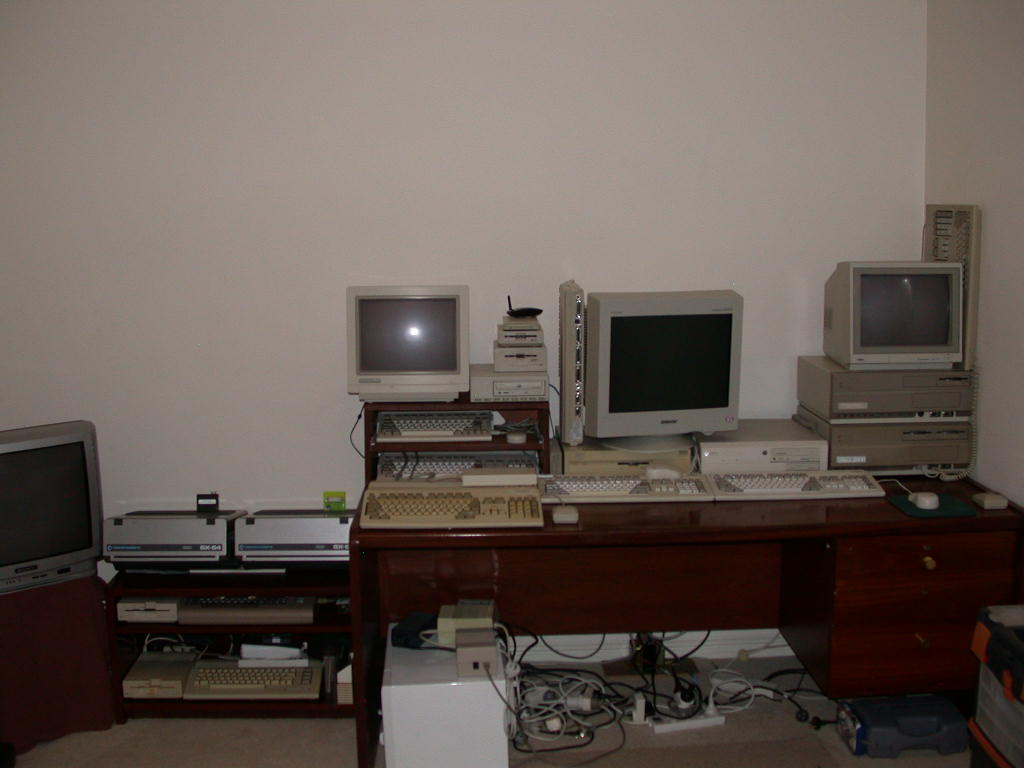
After many years I finally got all of my Amiga computers onto 1 desk in 1 room :-D
From left to right and top to bottom we have....
A1084-P1 monitor with A1010 and A1011 external floppy drives and an external SCSI CDROM (which is connected to the A3000)
A600
A1200 (new boxed Amiga Technologies Amiga Magic pack)
A500+ (front) with Gotek external drive configured as DF0:
A500 (it's my spare and is standing upright)
A3000 (with Sony G400 monitor)
A4000 (also connected to the G400 which has dual VGA inputs)
A1081 monitor (working like new since September 2014 because I replaced the flyback with a brand new one)
A2000
A2000HD
Almost all of these computers are accelerated and crammed to the max with fruity bits :-D
I'll post some more detailed pics of each computer soon (or sooner or later ;-)
|

The Retro Corner!
From right to left and top to bottom we have....
2 Commodore SX-64's (both with fast-load carts & SwinSID Nano)
Commodore 1541-II and old version Commodore 64 (with fast-load cart and SwinSID Nano)
Commodore 1541-II and Commodore 64C (with fast-load cart)
Commodore 64C (like new, with SD2IEC and fast-load cart)
Commodore 128D
A bunch of Nintendo Game & Watch games
Underneath that is The Retro Cabinet containing 5 consoles... see them to the right ==>
Next to that are two Fanuc System P Model G CNC Programming systems from 1983/1984 (both repaired and working well, one color and one green/mono)
|
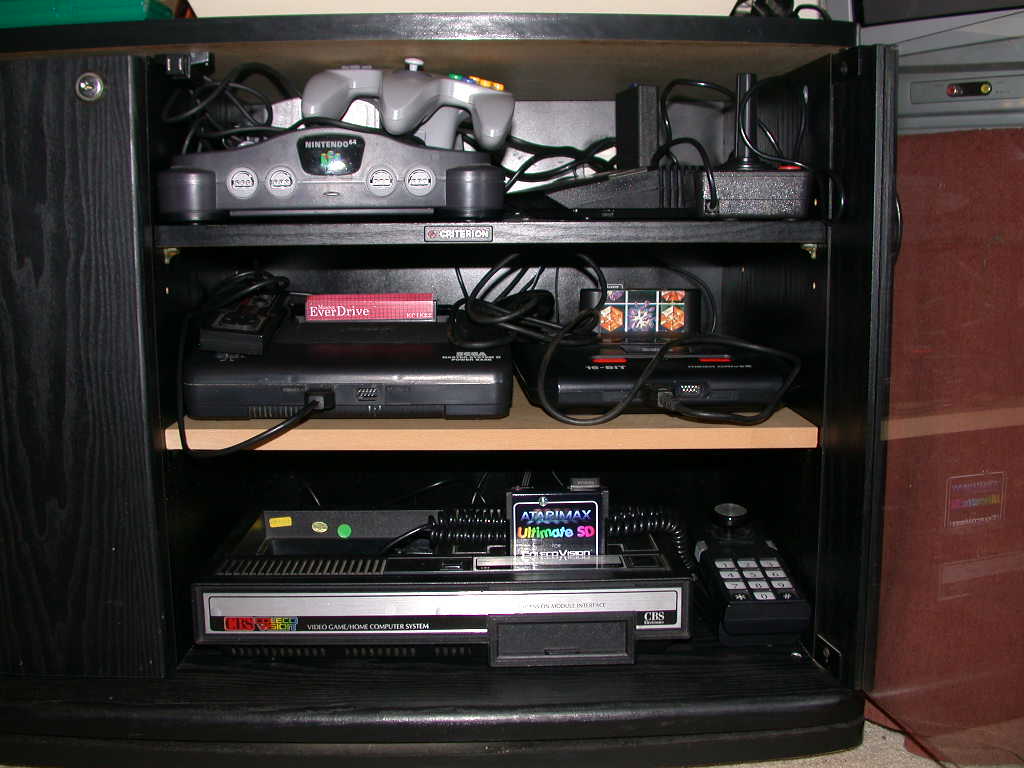
Close-up of The Retro-Cabinet
From left to right and top to bottom we have....
Nintendo 64, Atari 2600jr
Sega Master System II, Sega Mega Drive II
Colecovision
All of these consoles have a special plug-in cart with an SD-card containing all of the games for each console
This is retro gaming heaven in a box :-D
|
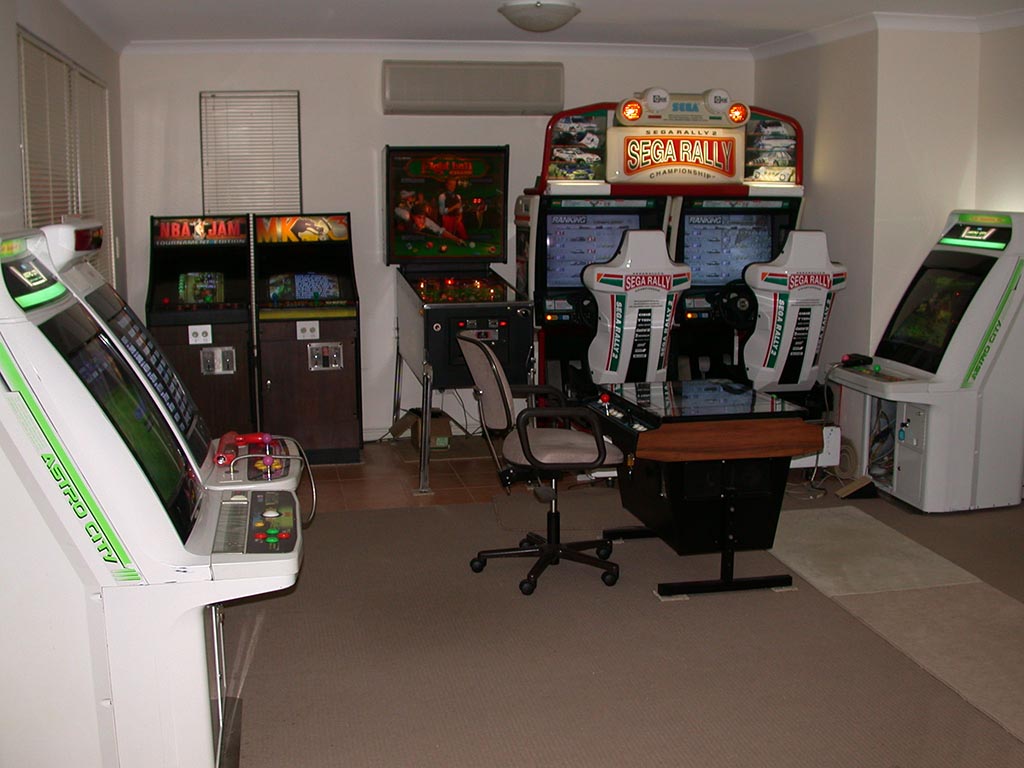
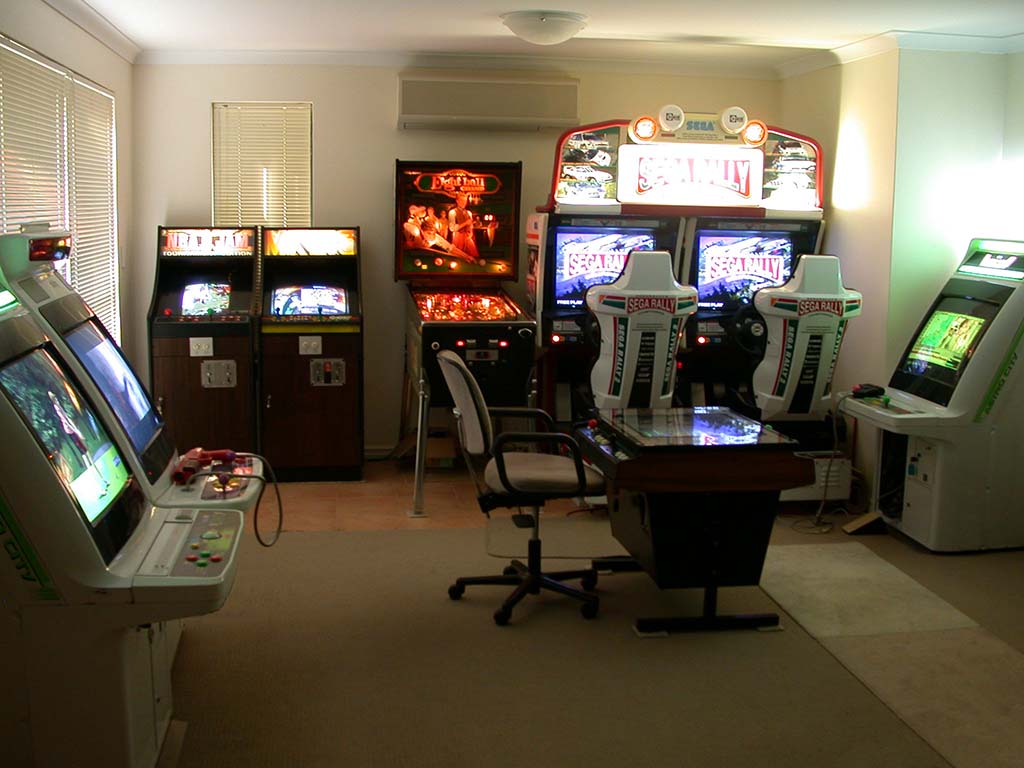
The Guru-Cade!
1st pic is with the camera flash on. 2nd pic is with camera flash off.
From left to right the games running are....
Sega's Dynamic Golf (3-D golf on NAOMI 1) running in a Sega Astro City cab with a Tri-res monitor. The game runs in VGA mode.
Konami's Warzaid (gun shooter) running in a Taito Egret II cabinet with Wells D9200 Tri-res monitor.
Psikyo's Strikers 1945-II (vertical shoot'em-up) running in a LAI Lowboy cabinet.
Midway's Ultimate Mortal Kombat 3 (fighting) running in a LAI Lowboy cabinet.
Bally-Midway Eight Ball Champ pinball machine.
Sega Rally 2 Twin (driving).
Namco's Time Crisis (gun shooter) running in a Sega Astro City cabinet.
In the middle is an original Hankin 20" cocktail machine from 1982 running a 60-in-1 vertical game board.
The board runs games like 1942, 1943, Galaga, Frogger, Pacman, Donkey Kong, Donkey Kong Jr, Gyruss, Dig Dug
Centipede, Phoenix, Time Pilot, RallyX, Xevious, Zaxxon and many other classics!
The full game list in PDF showing screen-shots of every game is available HERE
|
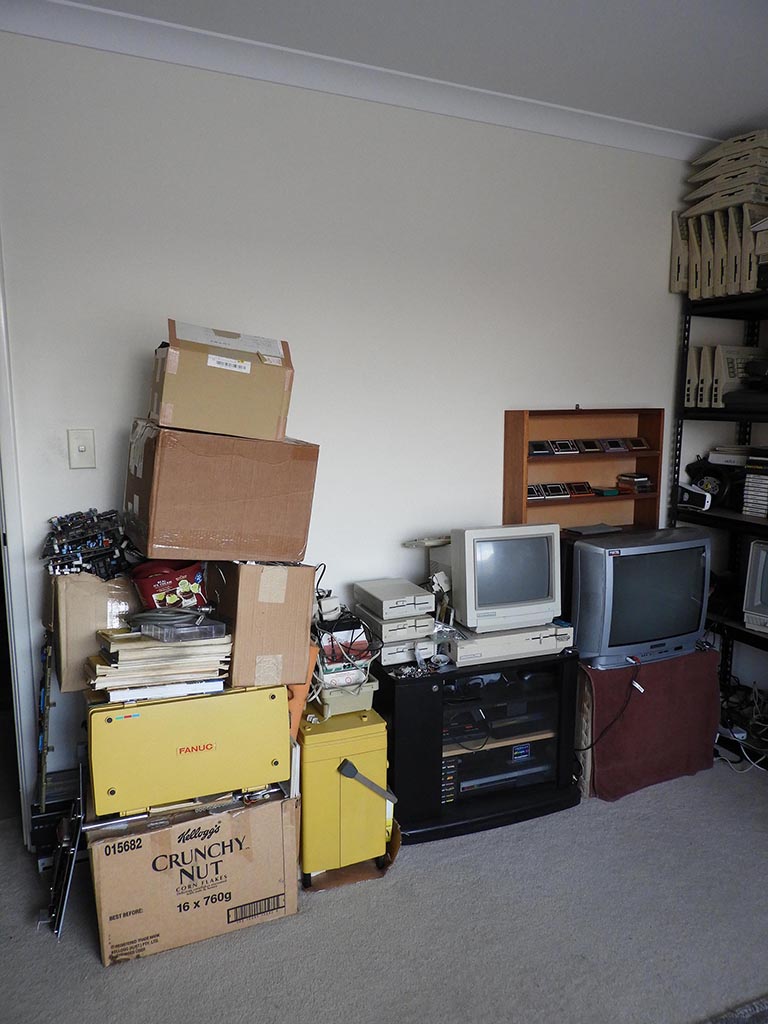



The Guru-Retro Room!
Lots of Commodore stuff and lots of other stuff too! How many items can you count? ;-)
|

Another EPROM programmer hehe! This is the successor to the very popular TL866-II Minipro. There are a few newer models
from that company because they were ripped off and mass-produced by the Chinese hehe! In the newest range they have the
TL866-II Plus, the XGecu T48 (which they also call the TL866-3G) and the top model is the XGecu T56. I bought the T56.
This programmer supports some newer NAND devices and other stuff that the other programmers don't support. This also
lacks a lot of stuff my other programmers support which is pretty normal so multiple EPROM programmers are required in
order to be a Dumping-Guru-Master hehe! This came with a bunch of adapters and other stuff. Most of them I already have
but the TSOP48/56 adapter is custom so that one is required for dumping TSOP48 NAND flash ROMs so I just bought the item
that came with everything.
|
|
|
| |



